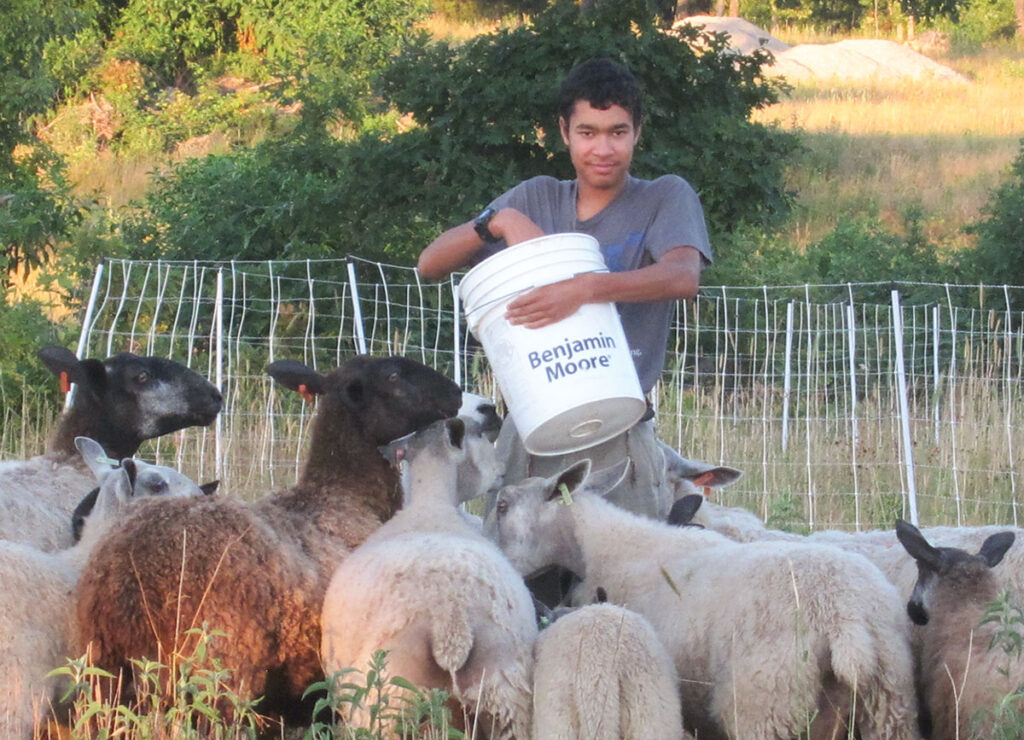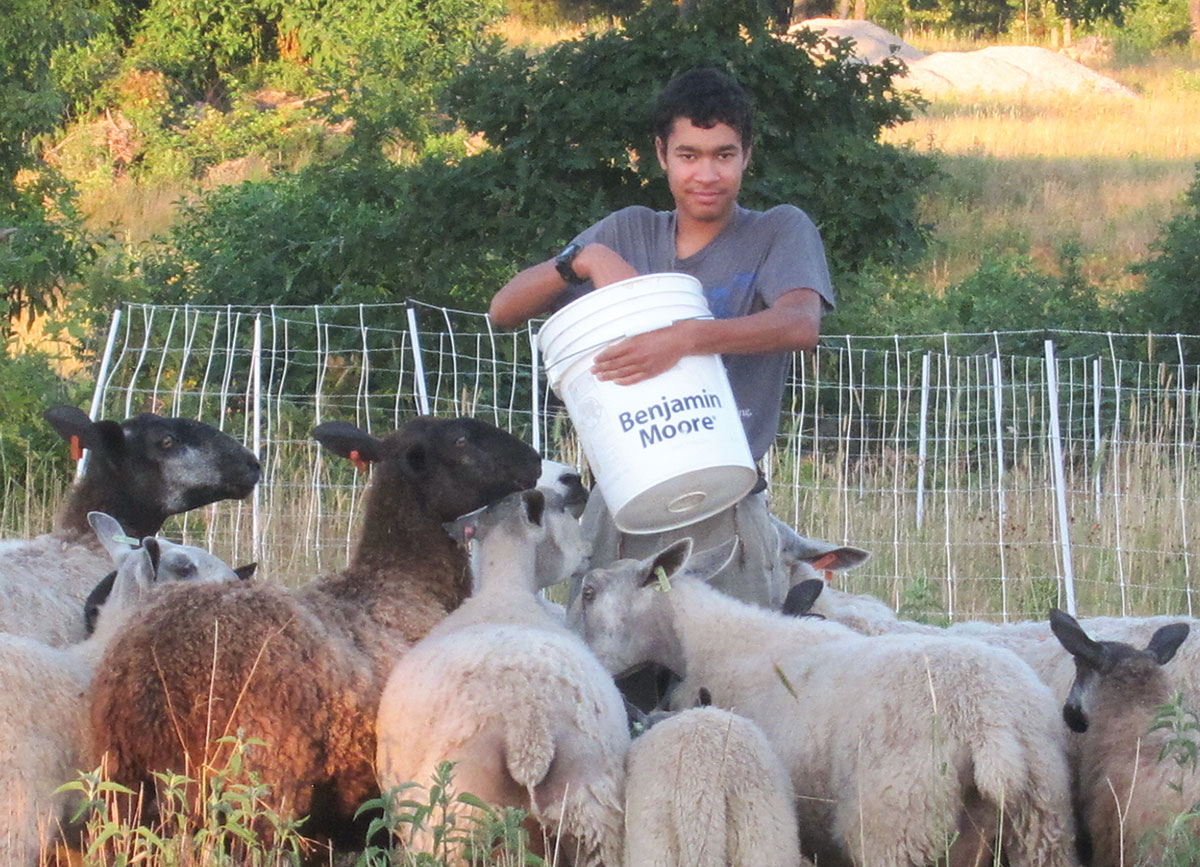
A desire to raise sheep leads teen to find a breed that works for his family’s farm
GROVESPRING, MO. – Before Jeremiah Ponds delves into a project, he does his research.
The 16-year-old from Grovespring, Mo., spent more than 300 hours researching sheep breeds to determine which was the right for him and his family’s farm.
“I have always enjoyed reading about farming since I was about 10 or 11,” he said, adding that Richard Perkins and Joel Saleton, considered experts in regenerative agriculture, are among his favorite authors. “About two or three years ago, I wanted to get sheep found this breed.”
Jeremiah chose Blueface Leicesters, a longwool breed developed in Dishley, Leicestershire, in the 1800s.
“I wanted them for their wool quality and their meat quality,” Jeremiah said, adding neither he nor his parents, Mark and Maggie Ponds, had any prior experience with sheep. Because they were novices in the industry, Mark stressed the need for additional research.
“I gave him an important project,” Mark said. “We looked at all of the sheep in the U.S., and he had to present the top four items about each one. He had to research not only how to maintain them but the wool and how to have a breeding program. This was an investment, and we wanted to make sure he did the work to justify the investment.”
There are only a handful of Blueface Leicester sheep in Missouri. Jeremiah said they were the “best British breed” because of their low input requirements and the breed’s ability to cross with other breeds to produce superior offspring. In the U.K., Blueface Leicester is crossed with other breeds to produce what is known as a “mule.”
“That cross makes up about 50 percent of their commercial wool exports,” Jeremiah said. “That’s something I am interested in because you can pretty much double wool production, and it’s a very soft wool, comparable to a Merino; that interests me.”
Venturing into crossbreeding in the future for fine wool production is an option, but Jeremiah wants to focus on building his herd. Additionally, a mule exhibits exceptional mothering ability, the meaty body of a Blueface Leicester with the added hardiness of another sheep breed.
“You have to have some really good stock to start with,” he said.
Jeremiah, a homeschool student, currently has about 10 ewes and 11 lambs. A registered Blueface Leicester ram breeds ewes, and this year was the first lambing season for Jeremiah.
“We do spring lambing,” he said. “This year, we lambed in April, but next year we want to be a little closer to March, early April.”
Jeremiah prefers ewes to produce twins for profitability, but triplets can result in extra labor.
“They really don’t handle triplets very well,” Jeremiah said of the Blueface Leicesters, which are large-bodied sheep.
Last year, the sheep were sheared in May, but because of the lambing schedule, shearing will be done in late February or early March, weather permitting. They currently have a professional shear, but the family hoped to learn more and take that chore upon themselves.
“You have to have some really good stock to start with.”
— Jeremiah Ponds
The wool of a Blueface Leicester is desirable for many hand spinners.
“I’m learning to process it myself,” Jeremiah said of the wool.
Being new to sheep production, Jeremiah said there was a learning curve. He said spending time with the flock to observe them has been very critical. At this time, the flock is forage-based, with ewes getting some grain in late gestation, and the hardy Blueface Leicesters have done well.
“I heard they were very picky, but they really aren’t. We have a couple of goats, and they eat the same things as the goats,” Jeremiah said. “We make sure they have grass and provide them with a good mineral; we haven’t had any issues. Blueface Leicesters are designed to be extremely hardy, and they have done extremely well on just grass. With this being our first year, I feel we have had very good weight gain in the lambs.”
Luckily, the farm had existing fencing for their Belted Galloway cattle, but the flock needed a structure for lambing. They invested in a Ketchman’s system for new mothers and lambs. After two or three days, the family goes back outside.
The sheep and cattle roam the same farm but are not grazed together.
“The only reason we don’t is because of the protection dogs,” Jeremiah said. “The cattle don’t like the dogs. We try to rotationally graze everything for parasite management. We follow basic principles like not overgrazing, leaving 3 inches (of grass), and ensuring everything have shade when it’s hot. We move the sheep twice away.”
In September, Jeremiah and the Pond family will be offering lambs for processing.
“Once we do that, we will have a better idea of how to improve the carcass,” Mark said.
Wool and meat are the primary products of Blueface Leicester sheep, but Jeremiah hopes to become a seedstock producer of the little-known breed. Jeremiah purchased his sheep from Caryn Miller in Smithville, Mo. Those sheep are from the genetic lines of some of the “original five bloodlines” of Blueface Leicester importers to North America.
“I want to get into the breeding stock side,” he said. “We have kept our hands on everything so far, but we are going to look at the meat lamb side. We will keep our breeding stock, but considering the lack of rain we’ve had the last few weeks, we may stick with what we have and not expand much more right now.”
“I think we will sell most of the lambs, and then with next year’s program, after we get a little more under our belt and Jeremiah gets a little more experienced, we will look at next year’s output and look at the situation,” Mark said. “I don’t want to get him any more than he can handle and take him away from school and other activities.”
Jeremiah may be a novice in raising sheep, but the teen has a passion for agriculture.
“Farming is one of my favorite things to do,” he said. “I am experimenting with some things, but I hope to stick with farming. The way I look is that eating is something everyone has to do, so if I stay in business, I will have a solid clientele.”
Jeremiah explained that the family has a small vineyard and orchard, and a large garden where he is honing his skills.
“We’ll see where it goes, but right now, I’m still 16 and have a couple of years to figure it out,” he said. “I am excited about it, and I just keep trying to figure out what works and what doesn’t work, and keep trying.”







